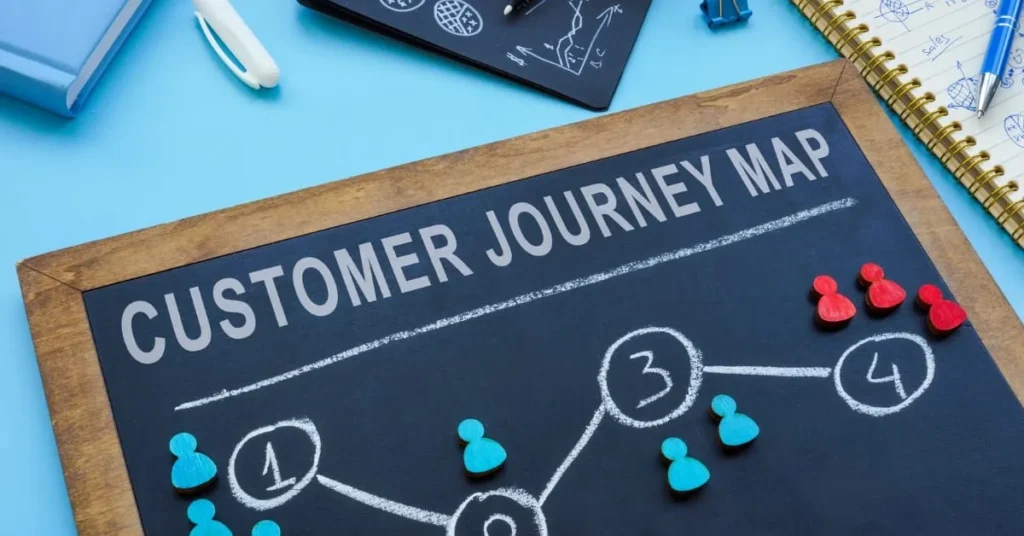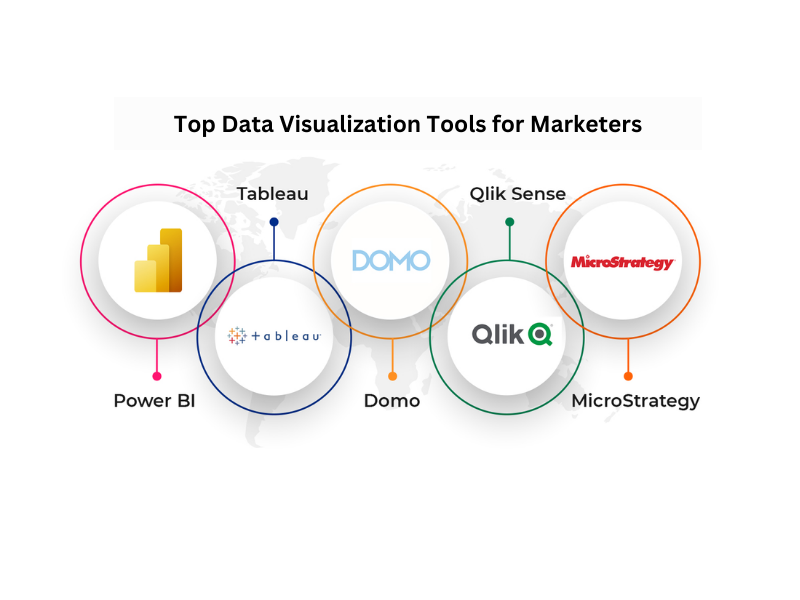Ever wondered why some marketing strategies click while others fall flat? The answer often lies in how well you understand your Customer Insights. In today’s competitive landscape, businesses that excel are the ones that truly get their customers—knowing not just what they buy, but why and how they buy it.
This blog post will be your guide to unraveling the mysteries of customer journeys. We’ll dive into how you can analyze each step your customers take and, more importantly, how to optimize these steps to turn casual visitors into loyal advocates. Ready to unlock those insights? Let’s get started.
Understanding the Customer Journey

To optimize a customer journey, you first need to understand what it actually entails. A customer journey is the entire experience a customer has with your brand, from the moment they first hear about you to when they become loyal advocates. It’s not just a single interaction; it’s a series of touchpoints that shape their perception and relationship with your brand.
Key Stages of the Customer Journey:
- Awareness: This is where your customer first learns about your brand. They might stumble upon your website through a Google search, see an ad, or hear about you from a friend. At this stage, the goal is to capture attention and make a strong first impression.
- Consideration: Now that they know you exist, they’re weighing their options. They’re comparing your products or services to others, reading reviews, and considering whether to engage further. This stage is all about building trust and providing valuable information that nudges them closer to a decision.
- Purchase: This is the critical moment where a customer decides to buy. It’s where all your previous efforts culminate. Ensuring a smooth, hassle-free purchase process is key to securing the sale.
- Retention: The journey doesn’t end with the purchase. Retaining customers is crucial for long-term success. At this stage, focus on delivering exceptional customer service, personalized communication, and incentives to keep them coming back.
- Advocacy: Happy customers can become your best marketers. When they love your brand, they’ll spread the word—whether it’s through word-of-mouth, reviews, or social media. Encouraging advocacy turns loyal customers into brand ambassadors.
Understanding these stages is the first step toward optimizing the journey. Each stage presents unique opportunities and challenges that can impact your overall success.
Tools and Techniques for Analyzing Customer Data
Now that you’ve got a grasp on the customer journey’s key stages, the next step is diving into data analysis. Analyzing customer data is like being a detective—piecing together clues that reveal what your customers really want and need. Here’s how to do it effectively.

Popular Tools for Customer Journey Analysis:
- Google Analytics: This is a go-to tool for understanding how visitors interact with your website. It provides insights into traffic sources, user behavior, conversion rates, and more. With features like goal tracking and funnel visualization, you can identify where customers drop off and where they’re most engaged.
- Customer Relationship Management (CRM) Systems: Tools like Salesforce, HubSpot, or Zoho CRM help you track interactions across different touchpoints. They provide a centralized database of customer information, which can be used to personalize communication and predict future behavior.
- Heatmaps (e.g., Hotjar, Crazy Egg): These tools show where users click, scroll, and spend the most time on your website. Heatmaps are invaluable for understanding which parts of a page attract the most attention and where users may be getting frustrated.
- Customer Feedback Tools (e.g., SurveyMonkey, Typeform): Direct feedback from your customers is gold. Use surveys and feedback forms to gather qualitative data that tells you how customers feel about their experience. This data is crucial for understanding the “why” behind customer behavior.
Data Sources:
- Surveys and Questionnaires: These can be distributed via email, social media, or directly on your website. Ask customers about their experiences, preferences, and pain points to gather insights that numbers alone can’t provide.
- User Behavior Analytics: Tools like Mixpanel or Amplitude allow you to track specific user actions, such as clicks, sign-ups, and purchases, across different devices and platforms. This helps in understanding how users navigate through your digital properties.
- Customer Feedback: Beyond surveys, keep an eye on reviews, social media comments, and support tickets. These often highlight areas where your customer journey could be improved.
Interpreting Data and Identifying Key Touchpoints: Once you’ve gathered your data, it’s time to analyze it. Look for patterns in behavior—where do customers spend the most time? Where do they drop off? Which channels drive the most conversions? Identifying these key touchpoints helps you understand where to focus your optimization efforts.
For example, if you notice a significant drop-off between the consideration and purchase stages, it might indicate issues with your checkout process. Similarly, if your retention rates are low, it could signal a need for better post-purchase engagement.
Optimizing Each Stage of the Customer Journey
Understanding the customer journey is one thing—optimizing it is another. Each stage presents unique opportunities to refine your approach, making sure customers move smoothly from one step to the next. Here’s how you can optimize each stage to maximize results.

1. Awareness: Strategies to Attract Potential Customers
- Content Marketing: Create valuable content that addresses your target audience’s pain points. Blog posts, videos, and infographics are excellent for attracting attention and establishing your brand as an authority in your niche.
- SEO and Paid Advertising: Ensure your content is easily discoverable through search engine optimization (SEO). For quicker results, invest in paid advertising like Google Ads or social media ads to reach a broader audience.
- Social Media Engagement: Actively engage with potential customers on platforms like Instagram, LinkedIn, and Twitter. Share content that resonates with their interests and encourages interaction.
2. Consideration: Enhancing Content and Engagement to Nurture Leads
- Email Marketing: Use targeted email campaigns to nurture leads. Send personalized content that aligns with their interests and addresses their specific needs, gradually guiding them towards making a decision.
- Webinars and Demos: Offer in-depth webinars or product demos to provide more detailed information about your offerings. This helps build trust and gives potential customers the confidence to move forward.
- Comparison Guides: Create content that directly compares your product or service with competitors. Highlight your unique selling points and explain why your solution is the best choice.
3. Purchase: Streamlining the Buying Process for Higher Conversion Rates
- Simplified Checkout Process: Reduce friction by making the checkout process as straightforward as possible. Limit the number of steps, offer guest checkout options, and provide multiple payment methods.
- Clear Call to Action: Ensure that your call to action (CTA) is prominent and compelling. Whether it’s a “Buy Now” button or a prompt to contact sales, make it clear what the next step is.
- Trust Signals: Incorporate trust signals such as customer reviews, testimonials, and security badges on your purchase pages to reassure customers that they’re making the right decision.
4. Retention: Techniques for Building Customer Loyalty and Repeat Purchases
- Loyalty Programs: Reward returning customers with loyalty programs that offer discounts, exclusive access, or points for future purchases. This incentivizes repeat business.
- Personalized Communication: Continue to engage customers with personalized emails that offer relevant products, updates, and special deals based on their purchase history.
- Excellent Customer Service: Provide responsive and helpful customer service. Whether through chat support, email, or phone, ensure that your customers feel valued and heard.
5. Advocacy: Turning Loyal Customers into Brand Advocates
- Referral Programs: Encourage happy customers to refer friends and family by offering rewards for successful referrals. This not only brings in new customers but also builds a community around your brand.
- User-Generated Content: Engage with customers on social media by encouraging them to share their experiences with your brand. Reposting their content not only builds loyalty but also serves as authentic marketing.
- Collect and Showcase Testimonials: Ask satisfied customers for testimonials and showcase them prominently on your website and marketing materials. Real-life success stories are powerful tools for building trust with potential customers.
By optimizing each stage of the customer journey, you create a seamless and satisfying experience that not only attracts new customers but also retains and turns them into advocates for your brand.
Case Studies of Successful Customer Journey Optimizations
Let’s explore how real-world businesses have successfully analyzed and optimized their customer journeys. These case studies will provide practical examples and insights you can apply to your own strategies.

Case Study 1: How a Retail Brand Boosted Sales by Improving the Customer Journey
Overview: A popular retail brand noticed that while they had a high number of website visitors, their conversion rates were lower than expected. The brand decided to focus on optimizing the customer journey to address this issue.
Approach:
- Customer Journey Mapping: The brand began by mapping out the entire customer journey, identifying key touchpoints such as product pages, the checkout process, and post-purchase follow-up.
- A/B Testing: They conducted A/B tests on various elements of the website, including product descriptions, images, and the placement of CTAs, to see what resonated best with customers.
- Streamlining Checkout: The checkout process was simplified by reducing the number of steps and offering multiple payment options, making it easier for customers to complete their purchases.
Results:
- Increased Conversion Rate: The optimizations led to a 25% increase in the conversion rate within three months.
- Higher Average Order Value: By implementing personalized product recommendations during checkout, the brand also saw a 15% increase in the average order value.
Lessons Learned: This case study highlights the importance of continuous testing and optimization. By focusing on user experience and simplifying processes, even small changes can lead to significant improvements in sales.
Case Study 2: A SaaS Company’s Approach to Reducing Churn Through Journey Analysis
Overview:
A SaaS company offering project management tools noticed a high churn rate among users after the first month of subscription. To address this, they decided to dive deeper into their customer journey to identify pain points.
Approach:
- Onboarding Experience: The company revisited its onboarding process, which was identified as a critical touchpoint. They introduced interactive tutorials and personalized onboarding emails to help new users get started quickly and efficiently.
- Customer Feedback: They collected feedback through surveys and direct user interviews to understand what was causing users to leave. Common issues included a steep learning curve and lack of customer support during the initial setup.
- Proactive Customer Support: The company implemented a more proactive customer support system, reaching out to new users within the first week to offer help and answer any questions.
Results:
- Reduced Churn Rate: Within six months, the churn rate dropped by 30%, as more users found value in the product during the critical early stages.
- Improved Customer Satisfaction: The changes also led to higher customer satisfaction scores, with more users reporting positive onboarding experiences.
Lessons Learned:
This case study demonstrates the importance of focusing on early-stage customer experiences. By improving onboarding and providing proactive support, the company was able to significantly reduce churn and increase customer loyalty.
Case Study 3: How a B2B Service Provider Increased Customer Advocacy
Overview: A B2B service provider specializing in digital marketing tools wanted to turn more of their satisfied customers into active brand advocates. They knew that many customers were happy with the service, but few were vocal about it.
Approach:
- Referral Program: They introduced a referral program that rewarded customers with discounts and exclusive offers for referring new clients. This gave satisfied customers a reason to actively promote the brand.
- Engagement Campaigns: The company launched engagement campaigns that encouraged customers to share their success stories on social media and in case studies. They also offered to feature these stories on their website and in newsletters.
- User-Generated Content: The provider encouraged customers to create user-generated content, such as blog posts or video testimonials, by offering incentives like free feature upgrades or extended service periods.
Results:
- Increased Referrals: The referral program led to a 20% increase in new client acquisition, with referred clients proving to be highly engaged and loyal.
- Boosted Advocacy: The number of customers actively promoting the brand on social media and through other channels doubled, significantly increasing the company’s online visibility.
Lessons Learned: This case study highlights the power of incentivizing customer advocacy. By making it easy and rewarding for customers to share their positive experiences, the company was able to leverage word-of-mouth marketing and build a community of brand advocates
Common Challenges and How to Overcome Them
Analyzing and optimizing the customer journey is not without its challenges. Let’s explore some common obstacles that businesses face and how you can overcome them to create a smoother, more effective customer experience.

1. Identifying and Addressing Data Silos
The Challenge: Data silos occur when customer data is stored in separate systems that don’t communicate with each other. This fragmentation makes it difficult to get a comprehensive view of the customer journey, leading to missed insights and opportunities.
How to Overcome It:
- Integrate Your Systems: Use tools like Customer Data Platforms (CDPs) or integrate your CRM, marketing automation, and analytics platforms to ensure data flows seamlessly between them.
- Centralize Data Management: Establish a central data repository where all customer information is stored and accessible. This allows for a unified view of the customer journey.
- Encourage Cross-Department Collaboration: Ensure that different departments, such as marketing, sales, and customer support, share data and insights. Regular meetings and shared dashboards can help break down silos.
2. Handling Inconsistent Customer Feedback
The Challenge: Customer feedback can be inconsistent or conflicting, making it hard to pinpoint specific issues or areas for improvement. Some customers might love a feature, while others might find it frustrating.
How to Overcome It:
- Segment Your Audience: Break down feedback by customer segments, such as by demographics, purchase history, or behavior. This helps you understand the preferences and pain points of different groups.
- Prioritize Based on Impact: Focus on feedback that comes from your most valuable customers or affects critical parts of the journey. This helps you make improvements that will have the most significant impact.
- Use Sentiment Analysis: Implement sentiment analysis tools to gauge the overall tone of customer feedback. This can help you identify patterns and prioritize issues that need addressing.
3. Balancing Personalization with Privacy Concerns
The Challenge: Customers expect personalized experiences but are also increasingly concerned about their privacy. Striking the right balance between using customer data for personalization and respecting privacy can be tricky.
How to Overcome It:
- Transparency: Be transparent about how you collect and use customer data. Clearly communicate your privacy policies and make it easy for customers to manage their data preferences.
- Data Minimization: Only collect the data you need to personalize the experience effectively. Avoid over-collecting data, which can lead to privacy concerns and data management challenges.
- Use AI and Automation Wisely: Leverage AI to create personalized experiences without needing to collect excessive amounts of personal data. For example, use predictive analytics to anticipate customer needs based on behavior rather than personal information.
4. Keeping Up with Changing Customer Expectations
The Challenge: Customer expectations are constantly evolving, and what works today might not work tomorrow. Staying ahead of these changes is crucial to maintaining a positive customer experience.
How to Overcome It:
- Continuous Learning: Regularly update your knowledge about market trends and customer behavior. Attend industry events, read relevant publications, and participate in customer experience communities.
- Feedback Loops: Create continuous feedback loops where you regularly gather and analyze customer feedback. This allows you to adapt quickly to changing expectations.
- Agile Marketing: Implement agile marketing practices that allow you to respond quickly to changes in customer preferences. This might include shorter campaign cycles, frequent A/B testing, and rapid iteration of strategies.
5. Measuring the ROI of Customer Journey Optimizations
The Challenge: It can be difficult to measure the return on investment (ROI) of customer journey optimizations, especially when the impact is spread across multiple touchpoints and over time.
How to Overcome It:
- Set Clear KPIs: Define specific, measurable key performance indicators (KPIs) for each stage of the customer journey. These might include metrics like conversion rates, customer lifetime value (CLV), or customer satisfaction scores.
- Attribution Models: Use advanced attribution models to track how different touchpoints contribute to your overall goals. Multi-touch attribution, for example, can give you a clearer picture of how each stage of the journey impacts the final outcome.
- Regular Reporting: Establish a regular reporting cadence to track the performance of your optimizations. Use dashboards and data visualization tools to make it easy to see trends and identify areas for improvement.
By proactively addressing these challenges, you can ensure that your customer journey optimizations are effective, scalable, and aligned with both customer expectations and business goals.
The Role of Customer Feedback in Journey Optimization
Customer feedback is the lifeblood of any successful journey optimization strategy. It provides direct insights into what your customers love, what frustrates them, and where there’s room for improvement. Let’s explore how to harness this valuable resource effectively.

1. How to Collect and Utilize Customer Feedback
Surveys and Polls:
- Best Practices: Keep surveys short and focused, asking specific questions about particular stages of the customer journey. Use a mix of multiple-choice questions and open-ended questions to gather both quantitative and qualitative data.
- Timing: Send surveys at key points in the customer journey—after a purchase, following customer service interactions, or upon reaching milestones in their user experience.
Customer Reviews and Testimonials:
- Encouraging Reviews: Prompt customers to leave reviews by sending follow-up emails post-purchase, offering incentives like discounts, or integrating review requests into your website or app.
- Utilization: Analyze reviews to identify common themes. Positive reviews can highlight what’s working well, while negative ones can pinpoint pain points that need addressing.
Social Media Listening:
- Monitoring Conversations: Use social media listening tools like Hootsuite or Brandwatch to track mentions of your brand across platforms. Pay attention to what customers are saying, both directly to you and in broader conversations.
- Engagement: Engage with customers on social media by responding to comments, addressing concerns, and thanking them for feedback. This not only improves customer satisfaction but also provides public examples of your brand’s commitment to listening and improving.
User Feedback Tools:
- In-App or On-Site Feedback: Implement feedback tools on your website or app, such as pop-up surveys or feedback forms that users can fill out while interacting with your platform. This captures feedback in real-time, offering context-specific insights.
- Analysis: Regularly review this feedback to identify trends. Are there specific areas where users consistently report issues? What features do they frequently praise or request?
2. Integrating Feedback into Your Customer Journey Analysis
Data Aggregation: Collect feedback from various sources and aggregate it into a single platform or dashboard. This makes it easier to see the big picture and identify consistent patterns across different touchpoints.
Actionable Insights:
Focus on extracting actionable insights from the feedback. For instance, if customers frequently mention long wait times during checkout, that’s a clear signal to streamline that process. If they praise your customer service team, consider how you can amplify that strength across other touchpoints.
Prioritization
Not all feedback is equal. Prioritize issues that impact critical stages of the customer journey, such as the purchase or onboarding stages. Addressing these can lead to the most significant improvements in customer satisfaction and business outcomes.
3. The Impact of Continuous Feedback on Journey Improvements
- Iterative Improvements:
Customer journeys are dynamic and should be treated as such. Continuously gather feedback, implement changes, and then re-assess. This iterative process helps you stay aligned with evolving customer expectations and market conditions. - Building Customer Trust:
When customers see that their feedback leads to real change, it builds trust and loyalty. Be transparent about the changes you’re making based on their input. This could be communicated through follow-up emails, blog posts, or updates on your website. - Enhanced Customer Experience:
By regularly integrating customer feedback into your journey optimization efforts, you create a more responsive and customer-centric experience. This not only improves satisfaction but also fosters long-term loyalty and advocacy.
Customer feedback isn’t just a tool for solving problems—it’s a strategic resource that can guide your entire optimization process. By actively listening and responding to your customers, you can ensure that every stage of their journey is as smooth and satisfying as possible.
Integrating Customer Journey Insights with Marketing Automation
Integrating customer journey insights with marketing automation is like supercharging your efforts. It allows you to deliver personalized experiences at scale, ensuring that each customer gets the right message at the right time. Here’s how you can make the most of this powerful combination.

1. The Benefits of Combining Journey Insights with Automation
- Personalization at Scale:
Marketing automation tools allow you to personalize communication based on the insights you’ve gathered from customer journey analysis. Whether it’s sending targeted emails, personalized product recommendations, or customized landing pages, automation helps you deliver relevant content to each customer segment without manual effort. - Efficiency and Consistency:
Automation ensures that your marketing efforts are consistent and timely. For example, triggered emails based on customer behavior—such as cart abandonment reminders—can be automatically sent at the optimal time, improving conversion rates and reducing manual work. - Data-Driven Decision Making:
By integrating journey insights with your automation platform, you can continuously refine your strategies based on real-time data. This leads to more informed decisions, allowing you to quickly adapt to changing customer behavior and preferences.
2. Tools and Strategies for Seamless Integration
- Customer Data Platforms (CDPs):
CDPs like Segment or Adobe Experience Platform collect and unify customer data from multiple sources. This consolidated data can then be used to trigger automated marketing campaigns tailored to each stage of the customer journey. - Marketing Automation Platforms:
Tools like HubSpot, Marketo, or ActiveCampaign offer robust automation features that can be customized based on customer journey insights. For example, you can set up workflows that automatically send targeted content based on where a customer is in their journey—whether they’re just browsing, considering a purchase, or already a loyal customer.
Behavioral Triggers:
Use behavioral triggers to automate actions based on specific customer behaviors. For instance:
- Email Nurture Campaigns: Automatically send a series of emails to nurture leads based on their interaction with your website, such as downloading a whitepaper or signing up for a webinar.
- Retargeting Ads: Serve personalized ads to customers who have visited your site but haven’t converted, reminding them of the products they viewed or offering special discounts.
- Post-Purchase Follow-Ups: Automate follow-up emails after a purchase to thank the customer, suggest complementary products, or request feedback.
3. Real-World Examples of Successful Automation Implementations
- Example 1: E-commerce Retargeting Success
An online fashion retailer integrated customer journey insights with their marketing automation platform to enhance their retargeting efforts. By tracking which products customers viewed and left in their carts, they set up automated email and ad campaigns that featured those exact items, along with time-sensitive discounts. This approach led to a 20% increase in recovered cart sales. - Example 2: SaaS Onboarding Optimization
A SaaS company improved its user onboarding process by automating a series of emails and in-app messages based on user behavior. If a new user didn’t complete the setup process within a certain timeframe, the system automatically sent them a tutorial video and offered a one-on-one walkthrough. This personalized approach led to a 30% reduction in user churn during the first month. - Example 3: B2B Lead Nurturing
A B2B marketing firm used marketing automation to nurture leads over a long sales cycle. By integrating CRM data with their automation platform, they created tailored email sequences for different buyer personas. Each sequence was triggered by specific actions, such as attending a webinar or downloading a case study. The result was a 25% increase in lead-to-customer conversion rates.
4. Best Practices for Maximizing the Impact of Automation
- Test and Optimize:
Continuously test your automated campaigns to see what works best. A/B testing subject lines, content, and timing can help you refine your approach and maximize results. - Maintain Human Touchpoints:
While automation is powerful, it’s important to maintain human touchpoints, especially in complex customer journeys. For instance, consider following up automated emails with a personal outreach from a sales representative when dealing with high-value leads. - Monitor and Adjust:
Regularly monitor the performance of your automated campaigns and be ready to adjust based on the data. If a particular workflow isn’t delivering results, dig into the analytics to understand why and make necessary changes.
By integrating customer journey insights with marketing automation, you can create highly personalized and efficient marketing strategies that drive better results. This powerful combination not only enhances customer experiences but also significantly improves your marketing ROI.
Conclusion
Understanding and optimizing the customer journey is no longer a luxury—it’s a necessity for businesses that want to thrive in today’s competitive landscape. By carefully analyzing each stage of the journey, from awareness to advocacy, you can identify key touchpoints and opportunities for improvement that will enhance the overall customer experience.
Incorporating customer feedback into your journey analysis allows you to stay in tune with what your customers need and expect, ensuring that your strategies remain relevant and effective. And when you combine these insights with the power of marketing automation, you can deliver personalized, timely experiences that build stronger relationships and drive better results.
Remember, the customer journey is dynamic and ever-evolving. Continuous learning, testing, and optimization are key to staying ahead. By focusing on these areas, you’ll not only improve customer satisfaction and loyalty but also create a sustainable growth engine for your business.














